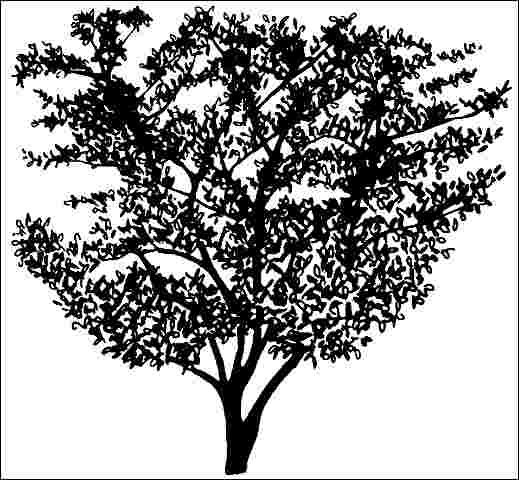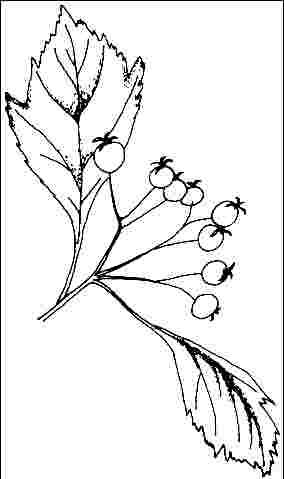Crataegus viridis 'Winter King': 'Winter King' Southern Hawthorn1
Introduction
'Winter King' southern hawthorn is a North American native tree which slowly reaches 20 to 30 feet in height and spread. It is very dense and thorny which makes it a popular choice for use as a hedge or as a screen. Unlike other hawthorns, the thorns are small and inconspicuous. The dark green, deciduous leaves turn beautiful shades of bronze, red, and gold in the fall before dropping. The handsome, silver-grey bark peels off in sections to reveal the inner orange bark, making 'Winter King' southern hawthorn a striking specimen planting in the winter landscape. The white blooms are followed by large, orange/red fruits which persist on the naked tree throughout the winter, adding to its landscape interest. The tree was originally selected for the outstanding winter berry color. The original tree from which the cultivar was selected is about 100 years old and 25 feet tall.

General Information
Scientific name: Crataegus viridis
Pronunciation: kruh-TEE-gus VEER-ih-diss
Common name(s): 'Winter King' southern hawthorn, 'Winter King' green hawthorn
Family: Rosaceae
USDA hardiness zones: 4A through 7B (Fig. 2)
Origin: native to North America
Invasive potential: little invasive potential
Uses: specimen; screen; hedge; reclamation; urban tolerant; container or planter; street without sidewalk; tree lawn 3–4 feet wide; tree lawn 4–6 feet wide; tree lawn > 6 ft wide; parking lot island < 100 sq ft; parking lot island 100–200 sq ft; parking lot island > 200 sq ft
Availability: not native to North America

Description
Height: 20 to 30 feet
Spread: 20 to 30 feet
Crown uniformity: symmetrical
Crown shape: vase, round
Crown density: moderate
Growth rate: moderate
Texture: fine
Foliage
Leaf arrangement: alternate (Fig. 3)
Leaf type: simple
Leaf margin: lobed, serrate
Leaf shape: ovate
Leaf venation: pinnate
Leaf type and persistence: deciduous
Leaf blade length: less than 2 inches
Leaf color: green
Fall color: no color change
Fall characteristic: not showy

Flower
Flower color: white/cream/gray
Flower characteristics: very showy
Fruit
Fruit shape: round
Fruit length: less than .5 inch, .5 to 1 inch
Fruit covering: fleshy
Fruit color: red, orange
Fruit characteristics: attracts birds; showy; fruit/leaves not a litter problem
Trunk and Branches
Trunk/bark/branches: branches droop; showy; typically multi-trunked; no thorns
Pruning requirement: needed for strong structure
Breakage: resistant
Current year twig color: brown, reddish
Current year twig thickness: medium
Wood specific gravity: unknown
Culture
Light requirement: full sun
Soil tolerances: clay; sand; loam; acidic; alkaline; well-drained; occasionally wet
Drought tolerance: high
Aerosol salt tolerance: low
Other
Roots: not a problem
Winter interest: yes
Outstanding tree: yes
Ozone sensitivity: unknown
Verticillium wilt susceptibility: resistant
Pest resistance: resistant to pests/diseases
Use and Management
The multiple trunks and wide pyramidal to rounded shape make this adaptable tree well suited for the low maintenance landscape as a specimen. If lower branches are removed from the trunks, a more vase shape can be maintained. It has become quite popular and is available in many areas.
'Winter King' southern hawthorn should be grown in full sun on well-drained soil. It is a very adaptable tree well suited for the urban landscape. The short thorns are usually not a problem, even on trees planted near streets. It is among the best of the many hawthorns that are available, receiving the Pennsylvania Horticultural Society's 1992 Styer Gold Medal Award.
Transplant in the spring for best establishment.
Propagation is by grafting.
Pests
Problem pests are aphids, borers, caterpillars, and leaf miners.
Diseases
It is susceptible to cedar-hawthorn rust but is more resistant than the species.


